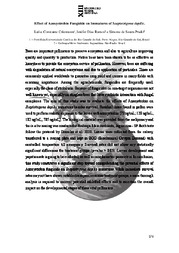Effect of azoxystrobin fungicide on immatures of Scaptotrigona depilis.
Effect of azoxystrobin fungicide on immatures of Scaptotrigona depilis.
Author(s): CRISTMANN, L.; J. D. RAMOS; PRADO, S. de S.
Summary: Bees are important pollinators to preserve ecosystem and also to agriculture improving quality and quantity to production. Native bees have been shown to be as effective as honeybees to provide the ecosystem service of pollination. However, bees are suffering with degradation of natural ecosystems and due to application of pesticides. Those are commonly applied worldwide to guarantee crop yield and income in many fields with economic importance. Among the agrochemicals, fungicides are frequently used, especially the class of strobilurin. Because of fungicides on non-target organisms are not well known yet, especially on stingless bees that have symbiotic interaction with fungal complexes. The aim of this study was to evaluate the effects of Azoxystrobin on Scaptotrigona depilis immatures besides survival. Residual doses found in pollen were used to perform realistic exposure to the larvae with azoxystrobin [73 ng/mL; 128 ng/mL; 182 ng/mL; 705 ng/mL]. The biological material was provided from the meliponary and the in vitro rearing was conducted at Embrapa Meio Ambiente, Jaguariúna - SP. Both tests follow the protocol by Dorneles et al. 2020. Larvae were collected from the colony, transferred to a rearing plate and kept in BOD (Biochemical Oxygen Demand) with controlled temperature till emergency. Survival rates did not show any statistically significant differences the treatment groups (p-value > 0.05). Larvae development and pupation rate is going to be evaluated, as well as morphometric parameters. In conclusion, this study constitutes a significant step toward comprehending the potential effects of Azoxystrobin fungicide on Scaptotrigona depilis immatures. While immediate survival rates may not have shown notable discrepancies across treatment groups, a more thorough analysis is required to uncover potential sublethal effects and to ascertain the overall impact on the developmental stages of these vital pollinators.
Publication year: 2024
Types of publication: Abstract in annals or event proceedings
Unit: Embrapa Environment
Keywords: Azoxystrobin, Fungicides, Scaptotrigona depilis
Observation
Some of Embrapa's publications are published as ePub files. To read them, use or download one of the following free software options to your computer or mobile device. Android: Google Play Books; IOS: iBooks; Windows and Linux: Calibre.
Access other publications
Access the Agricultural Research Database (BDPA) to consult Embrapa's full library collection and records.
Visit Embrapa Bookstore to purchase books and other publications sold by Embrapa.

